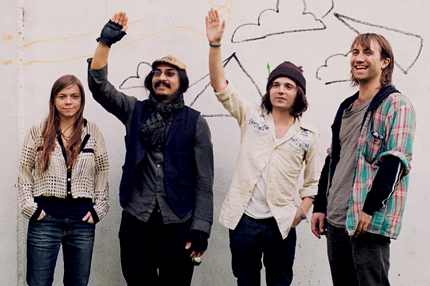Call it chillbilly, bootgaze, artisanal rock, outhouse, tin can alley, or hobohemian. But dismiss it at your own peril. The homegrown retro scene is here. [Magazine Excerpt]
Red Hook, Brooklyn, is isolated from the rest of New York City by New York Harbor, which sits to its south and west, and the Brooklyn-Queens Expressway, which slices through its eastern half. The neigh-borhood’s gentrification has been slow and spotty — there’s no subway stop nearby, and bus service is notoriously sporadic. Red Hook is salty and wild: a vestige.
On a bright Sunday afternoon, I make my way to Jalopy Theatre, a small performance space on Columbia Street, near the glowing entrance to the Brooklyn Battery Tunnel. A scrum of aspiring performers — almost all under 30 and most sporting vintage eyeglasses and nose rings — has gathered near the door. One by one, we check in with a woman behind the counter and watch as a few hopefuls are politely shooed away. Jessy Carolina, wearing a red flannel shirt, aviators, and a black knit cap, introduces herself; we fork over $20 each and follow a massive dog named Pirate to a smaller room upstairs.
There, Carolina, broadcasting old blues and zydeco songs from her MacBook, teaches the fundamentals of washboard playing: “There are no notes, you just have to feel it,” she insists, handing out thimbles and bottle caps. If you’ve never been in a ten-by-four room crammed with eight amateur washboard players simultaneously attempting to discover their style, you have not experienced actual cacophony. The class taps and scratches along to Uncle Dave Macon, a banjo player and vaudevillian who died in 1952. “It’s boom-chk, boom-chk, uh-uh-uh,” Carolina instructs, moving around the room, sipping her Yuengling.
A decade ago, few would have predicted that a washboard workshop — in a marginal neighborhood in a big northern city — could ever be so popular that people would be getting turned away at the door. But here we are.
“Americana” suggests a million different things: a Norman Rockwell painting, a pickup truck, an oven-hot apple pie served on a picnic table with perfect scoops of vanilla ice cream. In music, it’s a catch-all term for songs that are influenced, in part, by the indigent, rural, acoustic traditions (namely blues, bluegrass, country, and old-time) of the American South. It’s populist, minimally produced, rowdy, and sincere. It’s also enjoying an unexpected commercial and cultural renaissance, particularly among the indie-rock set.
This spring and summer, acts like Mumford & Sons, Old Crow Medicine Show, Carolina Chocolate Drops, Those Darlins, the Civil Wars, the Low Anthem, the Head and the Heart, the Band of Heathens, Amanda Shires, O’Death, David Wax Museum, Delta Spirit, and the Brothers Avett, Felice, and Punch are expected to attract rabid, bowler-hatted crowds who will scream along with every heartfelt word, even if they can’t all tell a mandolin from a dobro.
Although Americana has never been a lost genre, it has been recharged for a broader audience before: In the 1960s, Bob Dylan scuffed up his boots, committed the Woody Guthrie songbook to memory, strapped on a Double-O Martin acoustic, and spearheaded a Greenwich Village-based folk revival that ultimately reshaped pop music. And more recently, in 2001 — arguably the commercial apex of nü-metal and prefab pop, two genres about as far from a banjo riff as music gets — the O Brother, Where Art Thou? soundtrack, a collection of scrappy bluegrass and old-time tunes, joined Linkin Park’s Hybrid Theory, ‘N Sync’s Celebrity, and Staind’s Break the Cycle at the top of the year-end sales chart, moving a mind-boggling nine million albums worldwide.
By then, indie bands had already been assim-ilating bits and pieces of Americana music for at least a decade, but it was typically in the spirit of reinvention, not recovery. In the early 1990s, so-called alt-country acts like Uncle Tupelo (and later Wilco), Whiskeytown, and Freak-water rejiggered classic country into something wilder, messier, and more palatable for punks. Later, troubadours like Ryan Adams and Iron & Wine brought their versions of country and folk to dark-and-sticky rock clubs, inadvertently making more space for outsider acts like Will Oldham, who released his first record with Palace Brothers in 1993. Even less explicit homages became more common as the aughts rolled on (see the freak-folk of Devendra Banhart and Joanna Newsom, which nods to British artists Bert Jansch and Vashti Bunyan as much as it borrows from American pioneers like John Jacob Niles and Emmett Miller). But Americana itself was still a relatively small, insular genre, populated by niche acts such as Gillian Welch, Dave Rawlings, Alison Krauss, and “newgrass” innovators Tony Rice and David Grisman. When most people thought of Americana, if they thought of it at all, it was while reading about nontelevised Grammy categories.
But now — a few months before bluegrass godfather Bill Monroe would have celebrated his hundredth birthday — Americana seems newly ubiquitous. “I feel like in the past decade, this thing has been swelling,” says Scott Avett of the North Carolina–based Avett Brothers. That growth can at least be partially attributed to his band’s strummy mélange, which has become emblematic of a new Americana (a style that, incidentally, is no longer exclusively enjoyed — or made — by Americans). The Avetts’ collaboration with Mumford & Sons and Bob Dylan at this year’s Grammys felt like a watershed moment for a burgeoning pop movement.
For Avett, Americana is more of an ethos than a sound — it’s simply a commitment to doing it yourself and focusing on feeling and craft. “Pick up some instruments, write what you feel, sing what you feel, and you can’t go wrong,” he says. “You might not get a lot of people, you might not make a lot of money, but you can’t go wrong doing that.”
Indeed, more than any single musical thread, the idea uniting these bands is their joint pursuit of Americana “feeling” — a warm-and-friendly guilelessness that’s been largely absent from the pop landscape for years (and from indie rock almost forever). They may borrow from ancient strains of folk music, but their sepia-toned approximation of those sounds is almost incidental: It’s all about the heart. Josiah Johnson, a vocalist in the aptly named the Head and the Heart — possibly the first band to be championed by Dave Matthews before signing to Sub Pop, thus uniting two segments of the music world that are traditionally opposed — agrees that these days, tenderness trumps ennui. “It’s music that’s made and delivered earnestly; I think that’s a useful way of categorizing what’s going on,” he says. “Across all of these bands, if there’s any trend, it’s moving away from the too-cool-for-school indie-rock vibe. It’s making something that people think is real.”





